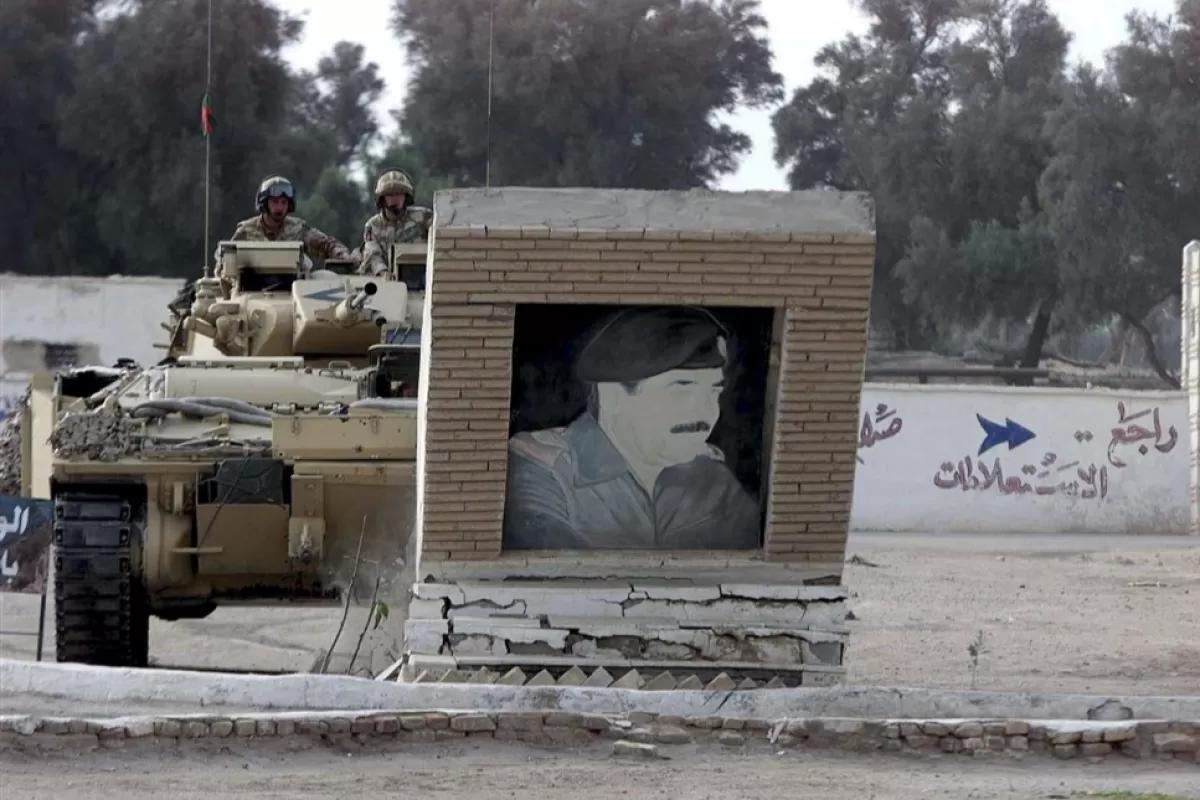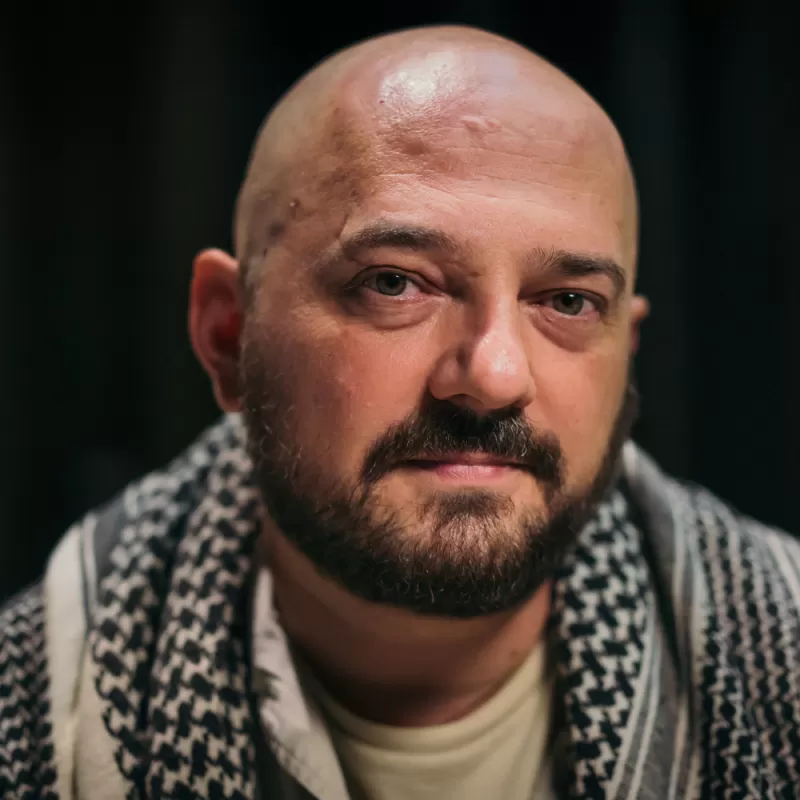
The war in Iraq started with a campaign against Saddam Hussein’s army and ended with the defeat of the Islamic State. In-between these milestones, the Sunnis and Shiites staged insurrections and started a civil war. Thousands of suicide bomb attacks were carried out during this period while battles left whole cities destroyed. Veridica presents the milestones of one of the most devastating conflicts in the Middle East.
March 20, 2003. The invasion
A US-led international coalition invaded Iraq, with the purported mission to decommission Saddam Hussein’s WMD arsenal, which could end up in the hands of Al-Qaeda terrorists. The main force of the coalition army, comprising American and British troops in particular, attacked from Kuwait. A second attack was launched from Iraqi Kurdistan and consisted of Peshmerga assisted by American forces. As part of a blitzkrieg campaign, the coalition had taken Baghdad by April 9, a key moment symbolized by pulling down Saddam Hussein’s statue in the central city square. On May 1, president George W. Bush announced “the end of major military operations”.
April – May, 2003. The first signs of the Sunni insurrection
On April 4, American forces opened fire on Iraqi civilians protesting in Fallujah, a town on the Euphrates Valley, known for its residents’ pride and their adherence to tribal traditions, including blood feuds. On May 16 and 23, the head of the Coalition Provisional Authority (CPA), Paul Bremer, who was de facto ruler of Iraq, signed his first two orders. The first ridded the administration of all members of Baath, Saddam Hussein’s party, while the second disbanded the secret services and the army. Hundreds of thousands of people with military training, mostly Sunni, ended up without a job and the means to put food on the table. These three events would be critical to the mobilization of nationalists, Baathists and moderate Islamists against the coalition force and to the creation of the resistance against the Americans and their Iraqi collaborators.
August, 2003. A jihad is launched against the Americans and Shiites in Iraq
On August 19, the head of the UN mission to Iraq, Sergio Vieira de Mello, is killed in a suicide bomb attack in Baghdad. 10 days later, Ayatollah Mohammad Baqir al-Hakim, a major Shia cleric who had returned from his exile in Iran, was killed in the Shia holy city of Najaf. Both attacks were claimed by the Jordanian terrorist Abu Musab al-Zarqawi. His would be an extremely brutal terrorist organization, organizing countless suicide bomb attacks and beheadings in the years that followed. Zarqawi’s followers targeted not just their sworn enemies – Christians and Shiites, but also Sunnis, which stirred criticism from leaders of Al-Qaeda itself. A few years after Zarqawi’s death, the organization he led would become ISIS. Dabiq, the English language magazine of ISIS used a quote attributed to Zarqawi as its motto: “The spark has been lit here in Iraq, and its heat will continue to intensify — by Allah's permission — until it burns the crusader armies in Dabiq”.
December, 2003. The capture of Saddam Hussein
“Ladies and gentlemen, we got him”, Paul Bremer announced on December 13 in a press briefing televised around the world. Saddam had been the most wanted person in Iraq as early as April, when he fled Baghdad. The former dictator was the Ace of Spades in the deck of most wanted Iraqi playing cards, which the Americans had distributed to its troops to help apprehend the most wanted members of the Hussein administration. Nearly all were captured and tried by Iraqi courts of law, and many of them – including Saddam Hussein – were sentenced to death and hanged. Saddam’s sons, Uday and Qusay (the Ace of Hearts and the Ace of Clubs, respectively), made notable exceptions after being killed in July in a clash with American forces, as well as Saddam’s second-in-command, Izzat Ibrahim al-Douri (the King of Spades) who remained in hiding until 2020, the year of his death.
April 2004. Muqtada al-Sadr’s insurrection
In the spring of 2004, the Mahdi Army, a militia controlled by the populist young cleric Muqtada al-Sadr, declared war on American forces after in previous months Muqtada had been very vocal in his criticism against the international coalition and the United States in particular – which, just like Iran, he called “the Great Satan”. Muqtada al-Sadr belonged to one of the most respected families of Shia clerics. His father, Muhammad Sadiq al-Sadr (assassinated by order of Saddam Hussein) had been extremely popular among poor Shiites, who had named the biggest district in Baghdad after him. Al-Sadr’s insurrection marked the advent of the Shiite insurrection against American forces, which would later attract militias trained and funded by Iran. The Mahdi Army was defeated by the Americans in the summer of 2004. Years later, it suffered a new defeat following clashes with Iraqi government forces, yet both Muqtada al-Sadr and the pro-Iranian militias that joined his uprising in 2004 have preserved their influence and continue to dominate Iraq’s political life to this day.
April-May, 2004. The Abu Ghraib scandal
The American and later the international media published photos depicting Iraqi prisoners detained at Abu Ghraib subjected to torture and sexual abuse at the hands of American prison guards. Abu Ghraib had been the most notorious prison in Saddam Hussein’s regime, and the Americans used it as a detention center where they interrogated people suspected to be part of the resistance. Rumors about the abuses committed at Abu Ghraib had been circulating around Baghdad, the media had published a number of articles on this topic and the authorities had even opened an investigation, but the scale of the abuse and the gravity of war crimes committed here were only transparent in the photos (in following years, it turned out that the pictures that surfaced in the spring of 2004 had shown just a small part of the abuses perpetrated at Abu Ghraib). Although those responsible were held accountable and the Abu Ghraib abuses were condemned by American leaders, the scandal left a dent in the image of the United States: what happened at Abu Ghraib not only confirmed, but even exceeded the conspiracy theories and rumors about the Americans, which at any rate circulated in the Muslim world.
2006 – 2008. The Iraqi Civil War
On February 22, 2006, the Al-Askari mosque in Samarra was destroyed in an explosion. This is a holy site for Twelver Shiites, where two of the Imams they worship, Ali al-Hadi (the 10th) and Hassan al-Askari (the 11th) are buried. It is also in Samarra that Mahdi, the 12th Imam, a Messianic figure of Shia Islam, entered the Minor Occultation. The mosque was destroyed by order of Abu Musab al-Zarqawi, who for the last three years had been trying to trigger a civil war between Sunnis and Shiites, and the latter had previously not responded to any of the attacks. After the 2006 attack, however, Shiite militias took up arms. Two years of bloody clashes between the two Muslim communities followed, which ended only after Sunni tribes turned arms against the jihadis and the American army reinforced its military presence on the ground and changed its strategy – David Petraeus’s so-called “surge”.
-
The USA’s withdrawal from Iraq
The USA started to reduce their military presence in Iraq after the civil war. By December 2011, the Americans had withdrawn their troops from this country, where the situation had relatively stabilized, and the Iraqi security forces had proved they were capable of carrying out operations unassisted. The withdrawal was however one of the biggest mistakes in the war. Shortly afterwards, the Shiite government led by Nuri al-Maliki started persecuting the Sunnis, which ramped up hostility from this community towards Baghdad, at a time when the wounds of the civil war had not even fully healed. Remnants of Zarqawi’s jihadist organization took full advantage of the social unrest to recruit new troops among the Sunnis. Additionally, a wave of attacks targeted prisons, and hundreds of former insurgents were freed and were thus able to take up arms again. The Islamic State in Iraq, which was what Zarqawi’s organization was now called, was becoming a force to be reckoned with.
-
The Islamic State’s rise to prominence
After civil war broke out in Syria in 2011, the Islamic State in Iraq got involved in this conflict as well, taking on a new name – the Islamic State of Iraq and Syria (a reference to Greater Syria, or the Levant), or ISIS / ISIL. In 2014, the organization, which now had more combatants, better equipped and battle-seasoned, launched a military campaign in Iraq. Fallujah was the first city to fall. Later, in June, Iraq’s second-largest city, Mosul, was captured, followed by other settlements until most of the Sunni part of Iraq had fallen under ISIS’s control. The Iraqi army was outsmarted by a force that was vastly inferior in terms of numbers of equipment. Iraq was thus paying the price of endemic corruption, political clientelism and Al-Maliki’s anti-Sunni policies. ISIS changed its name once more, this time into the Islamic State and proclaimed the Caliphate, a form of statehood dating back to the Middle Ages which claimed authority over all Muslims. The leader of the Islamic State, Abu Bakr al-Baghdadi, was proclaimed Caliph, taking the name Ibrahim.
2014 – 2017. The American turnaround. The defeat of the Islamic State
The victories of the Islamic State prompted US president Barack Obama to redeploy American forces to Iraq just three years after the USA had pulled out. A new international coalition was set up, this time with the goal of fighting jihadis. Its intervention consisted mainly of aerial missions and special ops. American troops assisted local forces involved in the conflict: Peshmerga, the Iraqi army, but also other Shiite militias controlled by Iran, particularly by the commander of the Quds Force of the Revolutionary Guard, General Qassem Suleimani, who would later be killed by the Americans in Baghdad in 2020. Islamic State jihadis fanatically fought back the Americans in the cities they captured (Tikrit, Ramadi, Fallujah, etc.). The longest and bloodiest battle was that for Mosul, which left most of the city in ruins. After the battle for Mosul, the Islamic State lost the remaining territories it held in Iraq, and the acute stage of the war was over. Iraq however remains a hotbed of insurgency to this day, and people continue to die in terrorist attacks, assassinations, and civil unrest.


@Toader Păun.


